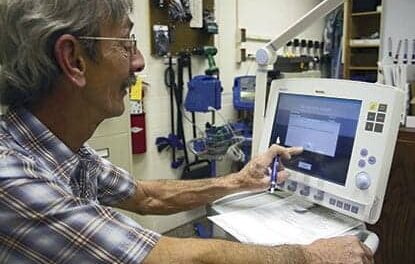A team of engineers and physicians at the University of California, San Diego has developed a low-cost, easy-to-use emergency ventilator for COVID-19 patients that is built around a ventilator bag usually found in ambulances.
The team built an automated system around the bag and brought down the cost of an emergency ventilator to just $500 per unit—by comparison, state-of-the-art ventilators currently cost at least $50,000. The device’s components can be rapidly fabricated, and the ventilator can be assembled in just 15 minutes. Moreover, the device’s electronics and sensors rely on a robust supply chain from fields not related to healthcare that are unlikely to be affected by shortages.
The UCSD MADVent Mark V also offers pressure-controlled ventilation equipped with alarms that can be adjusted to signal that pressure is too low or too high. This is especially important because excessive pressure can cause lung injury in COVID-19 patients that often experience rapid decreases in lung capacity as the disease progresses.
Most ventilators measure the volume of air that is being pumped into the patient’s lungs, which requires expensive airflow sensors. By contrast, the UCSD MADVent Mark V measures pressure and uses that data to deduct and control the airflow to the lungs. This was key to lowering the device’s price.
The team from UC San Diego and industry partners will be seeking U.S. FDA approval for the device. They detail their work in an upcoming issue of Medical Devices and Sensors. The device’s plans and specifications are available here.
“The MADVent can safely meet the diverse requirements of COVID-19 patients because it can adjust over the broad ranges of respiration parameters needed to treat acute respiratory distress syndrome,” says James Friend, a professor at the UC San Diego Jacobs School of Engineering and one of the paper’s two corresponding authors. “The combination of off-the-shelf components and readily machined parts with mechanically driven pressure control makes our design both low cost and rapidly manufacturable.”
Researchers also wanted to make sure that the device could be used by healthcare workers with limited experience with ventilators and no experience with this type of system, says Casper Petersen, MD, co-author of the study and a project scientist in the department of anesthesiology at the UC San Diego School of Medicine. As a result, the MADVent Mark V is safe to use, easy to assemble, and easy to repair.
“This device could be a great option for use in situations where materials are scarce, such as when the normal supply chain breaks down, or in developing nations and hard-to-reach rural areas,” Petersen says.
Even so, the device is not meant as a substitute for the highly complex ventilators used in ICU. “Rather, our low-cost ventilator is meant to bridge an urgent gap in situations of a large surge in patients where we may not have enough life sustaining equipment,” says Lonnie Petersen, MD, an assistant professor at the Jacobs School of Engineering, adjunct professor at UC San Diego Health and the paper’s other corresponding author.
“Safety is our main priority; while the MADVent is a low-tech and low-cost device, it actually offers robust and patient tailored ventilation,” Petersen adds. “This really increases the safety for the patients suffering from the complex pulmonary infection and respiratory distress associated with COVID-19.”




